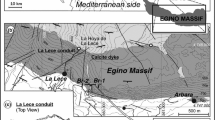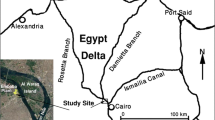Abstract
Riverbank filtration (RBF) is a proven treatment step in a multi-barrier method of drinking-water supply at many sites. RBF wells induce a large amount of river water to infiltrate the river base and travel towards the wells, giving the opportunity for mixing of infiltrated surface water and groundwater. Assessment of raw water quality plays an important role in planning and operating a RBF well field. In this context, the determination of the catchment area (and land uses within the catchment) and the ratio of bank filtrate (BF) to raw groundwater (GW) are two prior steps. Transient model simulations were performed in order to study the hydraulic conditions at the RBF well field at Grind near Düsseldorf, Germany. The BF/GW ratio was determined to be 75/25. The flood events in winter, in particular, showed the BF/GW ratio to have high variation. Transient path lines in the well field were used for delineation of the catchment area.
摘要
在很多地方, 河岸过滤 (RBF) 被证明是饮用水供给系统的多屏障方法中的可行的处理措施。河岸过滤井使大量的河水通过河床底部渗透并流入井中, 从而给渗入的地表水和地下水提供了混合的机会。原水的质量评价在设计和运行河岸过滤井中起着重要的作用。本文中, 流域区 (及流域内土地利用情况) 以及河岸渗滤水 (BF) 和天然地下水 (GW) 的比率的确定是两个优先考虑的内容。我们应用了瞬时水流模型来研究德国Düsseldorf Grind 井田的水力条件。得到的BF/GW比值为75 : 25。特别地, 冬季的洪水事件导致BF/GW的比值出现较大的波动。井田区的瞬时流动路径也被用来确定流域面积。
Résumé
La filtration des berges des rivières (FBV) est une étape reconnue de la méthode pluri-barrière du traitement de l’eau pour l’alimentation en eau potable appliquée à plusieurs sites. Les forages au niveau d’un champ captant de type FBV ont pour conséquence qu’une grande quantité d’eau de la rivière s’infiltre au niveau du lit de la rivière ; cette eau se déplace en direction des forages, offrant ainsi la possibilité aux eaux de surface et aux eaux souterraines de se mélanger. L’évaluation de la qualité de l’eau brute joue une rôle important concernant la planification et la mise en œuvre d’un champ captant de type FBV. Dans ce contexte, la détermination de la zone d’alimentation (et de l’occupation du sol au sein de cette zone) ainsi que le pourcentage d’eau filtrée par les berges (BF) par rapport à l’eau souterraine brute (ES) sont deux étapes primordiales. Des simulations à l’aide d’un modèle en régime transitoire ont été effectuées afin d’étudier les conditions hydrauliques du champ captant de type FBV, situé à Grind, près de Düsseldorf en Allemagne. Le rapport BF/ES a été défini avec une valeur de 75/25. Les événements de crue hivernales en particulier ont montré que ce rapport BF/ES offre une grande variation. Les lignes d’écoulement en régime transitoire dans le champ captant ont été utilisées afin de délimiter la zone d’alimentation.
Resumo
A filtração em margem de rio (FMR) é uma etapa comprovada de tratamento num sistema de barreiras múltiplas de abastecimento de água para consumo em muitos locais. As captações de FMR fazem com que um grande volume de água do rio se infiltre no leito e se desloque no sentido das captações, possibilitando a mistura de água superficial infiltrada com água subterrânea. A avaliação da qualidade da água bruta ocupa um papel importante no planeamento e operação de um campo de captações de FMR. Neste contexto, a determinação da área de drenagem (e do uso do solo dentro dessa área) e do ratio de água filtrada em margem (FM) sobre água subterrânea bruta (AS) são duas etapas precedentes. Foram efectuadas simulações de modelo em regime transitório no sentido de estudar as condições hidráulicas no campo de captações de FMR em Grind, perto de Düsseldorf, Alemanha. O ratio FM/AS foi determinado, sendo 75/25. Os episódios de cheias no inverno, em particular, demonstraram uma variação elevada do ratio FM/AS. As linhas de fluxo transitório no campo de captações foram usadas para a delimitação da área de drenagem.
Resumen
La filtración en riberas de ríos (FRR) es un paso esencial en el tratamiento multibarrera de aguas destinadas a abastecimiento de agua de bebida. La FRR induce a que grandes volúmenes de agua del río se infiltre por su cauce y migre hacia pozos de extracción, considerando que se produce una mezcla entre el agua infiltrada y el agua subterránea. La evaluación de la calidad del agua no tratada tiene un rol importante en el planeamiento y operación de un campo de bombeo abastecido parcialmente por FRR. En este contexto, la determinación del área de la cuenca (y de los usos de la tierra dentro de la cuenca) y la relación entre el agua filtrada en las orillas (AFO) y el agua subterránea (AS) son los pasos previos. A fin de estudiar las condiciones hidráulicas en el campo de bombeo FRR de Grind, cercano a Dusseldorf, Alemania, se llevaron a cabo simulaciones con modelos transitorios. Se determinó que la relación AFO/AS era de 72/25. Los eventos de crecidas, en particular en invierno, muestra que la relación AFO/AS tiene una gran variación. Para delinear el área de captación se utilizaron las trayectorias transitorias del flujo en el campo de pozos.











Similar content being viewed by others
References
Carrera J (1988) State-of-the-art of the inverse problem applied to the flow and solute transport problem. In: Custodia E, Gurgui A, Lobo P, Ferreira J (eds) Groundwater flow and quality modelling, NATO ASI Series C, Mathematical and physical science, vol 224. Reidel, Dordrecht, Germany, pp 549–583
Doussan C, Ledoux E, Detay M (1998) River-groundwater exchange, bank filtration, and groundwater quality: ammonium behavior. J Environ Qual 27:1418–1427
Eckert P, Irmscher R (2006) Over 130 years of experience with riverbank filtration in Düsseldorf, Germany. J Water SRT Aqua 55:283–291
Eckert P, Blömer C, Gotthardt J, Kamphausen S, Liebich D, Schubert J (2000) Correlation between the field catchment area and transient flow conditions. In: Jülich W, Schubert J (eds) IAWR Publ. No. 4. Proc. Int. Riverbank Filtration Conf., Düsseldorf, Germany, 2–4 November 2000, pp 103–115
Grischek T, Hiscock KM, Metschies T, Dennis PF, Nestler W (1998) Factors affecting denitrification during infiltration of river water into a sand and gravel aquifer in Saxony, Germany. Water Res 32(2):450–460
Grischek T, Schoenheinz D, Sandhu C, Hiscock KM (2005) River bank filtration: its worth in Europe and India. J Indian Water Resour Soc 25(2):25–30
Jacobs LA, Van Gunten HR, Keil R, Kuslys M (1988) Geochemical changes along a river–groundwater infiltration path: Glattfelden, Switzerland. Geochim Cosmochim Acta 52(11):2693–2706
Jha R, Ojha CSP, Sharma KD (2005) Evaluation of river bank filtration potential for selected cities in the Ganges plains. J Indian Water Resour Soc 25(2):39–54
König C (2006) SPRING user’s manual, version 3.3, Delta h Ingenieurgesellschaft Dortmund, Germany. Available via http://www.delta-h.de. Cited 26 June 2008
Kühn W, Müller U (2000) Riverbank filtration. JAWWA 92(12):60–69
Ray C, Grischek T, Schubert J, Wang Z, Speth TF (2002) A perspective of riverbank filtration. JAWWA 94(4):149–160
Schubert J (2002) German experience with riverbank filtration systems. In: Ray C, Melin G, Linsky RB (eds) Riverbank filtration: improving source water quality. Kluwer, Dordrecht, Germany
Schwarzenbach RP, Giger W, Hoehn E, Schneider J (1983) Behavior of organic compounds during infiltration of river water to groundwater: field studies. Environ Sci Technol 17:472–479
Stuyfzand PJ, Kooiman JW (1996) Elimination of pollutants during artificial recharge and bank infiltration: A comparison. In: Kivimäki A-L, Suokko T (eds) Artificial recharge of groundwater. Proc. Int. Symp., Helsinki, 3–5 June 1996, pp 223–231
Swamee PK, Mishra GC, Chahar BR (2000) Solution for a stream depletion problem. J Irrig Drain Eng 126(2):125–126
Von Gunten HR, Karametaxas G, Krähenbühl U, Kuslys M, Giovanoli R, Hoehn E, Keil R (1991) Seasonal biogeochemical cycles in riverborne groundwater. Geochim Cosmochim Acta 55(12):3597–3609
Acknowledgements
The groundwater modeling was performed by Vijay Shankar from Indian Institute of Technology, Roorkee during a scientific staff exchange as a part of the European Union (EU)-India Economic Cross Cultural Program. The authors are grateful to the EU for financial support under ASIA/2004/095–733. The project was managed by Dr. Dagmar Schoenheinz and Prof. Dr. Thomas Grischek from the University of Applied Sciences Dresden, Germany. We would like to thank them for their support during the project.
Author information
Authors and Affiliations
Corresponding author
Rights and permissions
About this article
Cite this article
Shankar, V., Eckert, P., Ojha, C. et al. Transient three-dimensional modeling of riverbank filtration at Grind well field, Germany. Hydrogeol J 17, 321–326 (2009). https://doi.org/10.1007/s10040-008-0356-4
Received:
Accepted:
Published:
Issue Date:
DOI: https://doi.org/10.1007/s10040-008-0356-4




